The War in the Air - Bombers: Germany, Zeppelins
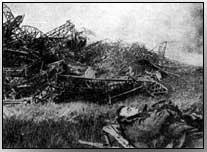 Balloons
had been used in wars prior to the First World War, notably by the Americans
in the civil war and the French during the siege of Paris in 1870.
This technology had been advanced by the development of dirigibles - cigar
shaped airships with frames, containing many gas balloons. Powered
with multiple engines, these craft could be flown in specific directions
rather than just follow the direction of the wind.
Balloons
had been used in wars prior to the First World War, notably by the Americans
in the civil war and the French during the siege of Paris in 1870.
This technology had been advanced by the development of dirigibles - cigar
shaped airships with frames, containing many gas balloons. Powered
with multiple engines, these craft could be flown in specific directions
rather than just follow the direction of the wind.
Germany had two dirigible manufacturers, the Schutte-Lanz Company, and the larger and better known Zeppelin Company. The latter was headed by Ferdinand von Zeppelin, the world's foremost designer of airships. To this day his name remains synonymous with dirigibles in general.
Airships of his design had already proven themselves capable of flying as far as England and back. This fact was not lost on the Allies, who from the very outset targeted the airship sheds. It was also not lost on the British public, where rumours and reported sightings of Zeppelins were frequent, though unfounded, throughout 1914.
At the outbreak of the war the German army had six operational dirigibles, and the navy had one. The army was quick to experiment with them - bombing Liege and Antwerp - despite the fact that at this stage no specially designed aerial bombs existed. But the army's initial experience was not encouraging - they lost three airships in the first months of the war to anti aircraft fire.
Despite this the navy was very enthusiastic. They saw the Zeppelin as a solution to their reconnaissance problems. If the army traditionally used the cavalry for reconnaissance, the navy traditionally used the light cruiser. Germany had very few such ships, and an airship was viewed as being cheaper and less vulnerable.
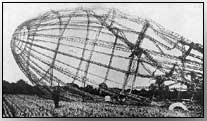 Under
the command of Korvettenkapitan Peter Strasser the navy quickly acquired
more airships. Throughout 1914 these were used for reconnaissance
patrols over the North Sea, but the German Admiralty was pressing for
permission to use them for attacks against England. The
Kaiser,
somewhat reluctantly, granted such permission and on the 19th of January the
Germans carried out the first Zeppelin raid against Britain, killing two and
injuring sixteen.
Under
the command of Korvettenkapitan Peter Strasser the navy quickly acquired
more airships. Throughout 1914 these were used for reconnaissance
patrols over the North Sea, but the German Admiralty was pressing for
permission to use them for attacks against England. The
Kaiser,
somewhat reluctantly, granted such permission and on the 19th of January the
Germans carried out the first Zeppelin raid against Britain, killing two and
injuring sixteen.
This was the first of many raids, which continued at a rate of about two per month, in parallel with the continuing reconnaissance patrols. The German Admiralty was very enthusiastic about the results, and asked for permission to bomb London. This was only granted by the Kaiser after a series of raids by French bombers on German cities. On the 31st of May 1915 the first raid was carried out against London, killing seven and injuring thirty five.
The most successful Zeppelin raid on London in the entire war was on the 8th of September 1915. This raid caused more than half a million pounds of damage, almost all of it from the one Zeppelin, the L13, which managed to bomb central London. This single raid caused more than half the material damage caused by all the raids against Britain in 1915.
On the night of 6-7 June 1915 Rex Warneford, a lieutenant in the RNAS, flying a Morane-Saulnier, was on a bombing mission against the Zeppelin sheds at Evere. When he spotted a Zeppelin returning from a bombing raid against London he decided to attack it. He tried shooting his carbine at it, his only armament, but he was driven off by the Zeppelin's defensive machine guns.
The airship began climbing, leaving the little plane behind, but Warneford, unbeknown to the Zeppelin crew, continued the pursuit, climbing slowly over two hours to an altitude of 13,000 feet. At this stage the airship began to descend in the direction of Brussels, and seizing his opportunity Warneford, now above the Zeppelin, dived towards it and from about two hundred feet above he dropped his six bombs on its roof.
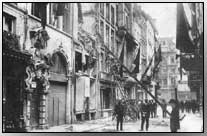 The
resultant explosion destroyed the Zeppelin, and almost destroyed Warneford's
fragile monoplane.
The
resultant explosion destroyed the Zeppelin, and almost destroyed Warneford's
fragile monoplane.
He was forced to put the plane down, behind enemy lines, but he managed to make sufficient emergency repairs to take off again and return to his base. LZ 37 was the first Zeppelin brought down by an airplane.
Warneford was awarded the Victoria Cross by the British, and the Knight's Cross of the Legion d'Honneur by the French, but his triumph was short-lived. He was killed ten days later in a flying accident.
This was an isolated incident. Throughout the remainder of 1915 the Zeppelins raided London frequently, and with impunity. They flew too high for most planes, and when they were intercepted by aircraft the ammunition in use at the time had little effect. Despite this impunity the material effect of the raids, with the exception of L13's success, was relatively slight.
Navigation was very primitive, and as the war progressed the British use of blackouts made it even harder. Bomb aiming was far from accurate. It is estimated that only 10% of the bombs dropped from Zeppelins actually hit their target. The psychological impact of these raids, however, was enough to cause the British to tie up 12 squadrons on home defence.
The Germans also bombed Paris. The first raid was on 21st of March, when two Zeppelins caused 23 deaths and injured 30. Although the Zeppelins continued to raid Paris, London was actually a preferred and easier target. The nearest Zeppelin base to Paris was at Metz, which meant flying close to 320 km (200 miles) over French territory each way, giving the defending airforce and anti-aircraft guns much more time to organize.
Raids against London had to cover nearly twice the distance, but most of the approach was over friendly territory and the sea. Paris was also protected by barrage balloons, a measure only taken by the British later in the war.
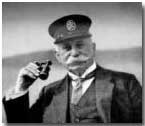 1916
did not start well for the Zeppelins. Four of them were lost carrying
out bombing raids during the
Battle of Verdun, and this
marked the last use of airships for tactical bombing. But Strasser
remained confident. The Zeppelin factory was producing a new
generation of airships - larger, more powerful, and with more engines.
1916
did not start well for the Zeppelins. Four of them were lost carrying
out bombing raids during the
Battle of Verdun, and this
marked the last use of airships for tactical bombing. But Strasser
remained confident. The Zeppelin factory was producing a new
generation of airships - larger, more powerful, and with more engines.
But it was also a year of change on the British side as well. Disappointment with the RNAS' failure to stop the Zeppelins resulted in the responsibility of home defence being given to the RFC. Happily for them this coincided with the arrival of improved ammunition.
Towards mid 1916 the British planes were armed with a mixture of explosive and incendiary bullets. This mixture would prove to be deadly to the airships: the explosive bullets could pierce the Zeppelin's tough outer skin and cause leaks on the inner gas bags. The incendiary bullets could set those leaks on fire, and once on fire a Zeppelin was doomed.
William Leefe-Robinson, flying a BE2c, was the first to shoot down a dirigible over Britain, on the 2nd of September, 1916. The massive fire of the burning airship was visible for over a hundred miles. This was during a raid of twelve naval airships which were, somewhat unusually, accompanied by four army airships. Leefe-Robinson became an instant hero. He survived the war, only to die a month later in the influenza epidemic.
Strasser's confidence remained unshaken. Leefe-Robinson had shot down the SL11. It was an army airships, not one of Strasser's, and moreover an old Schutte-Lanz dirigible with a wooden frame.
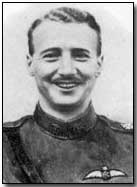 But
Strasser's confidence was misplaced. Three weeks later he was to lose
two airships, out of a total of twelve taking part in a raid. There
were no comforting explanations. They were naval airships. They
were the most up to date Zeppelins available.
But
Strasser's confidence was misplaced. Three weeks later he was to lose
two airships, out of a total of twelve taking part in a raid. There
were no comforting explanations. They were naval airships. They
were the most up to date Zeppelins available.
The L33 had been hit by anti aircraft fire. She did not catch fire, but she was forced to land in England. The crew all survived, and set her alight before capture. The L32 was shot down by a plane, and as in the case of Leefe-Robinson's SL11, it caught fire. Nor were these the last losses in 1916.
Despite flying almost four times as many sorties as in 1915, and dropping almost five times as many bombs, Strasser's fleet caused only about two thirds as much damage as they had in 1915.
The German military was becoming disillusioned with the Zeppelins, and began using the new Gotha and Giant bombers to attack Britain, but Strasser remained convinced. The answer was to fly higher, above the defending aircraft. Thus was conceived the third generation of Zeppelins, the "Height Climbers", airships capable of reaching an altitude of 20,000 feet.
In order to reach these heights defensive armaments were reduced, as was the strength of the frame. Flying at such altitudes produced a whole new set of problems. The extreme cold and thin oxygen affected both the engines, and the crew's capability to function.
Bomb aiming and navigation became even harder. But with the renewed immunity the height seemed to offer, it seemed worth the price. Indeed, when on the night of October 19th 1917 a fleet of eleven Height-Climbers crossed the English coast they were too high to be heard, and their raid was a total surprise.
But on the return journey, over the European mainland, almost half the airships were shot down by British and French fighter aircraft as they descended towards landing. The L55 had attempted to avoid this risk by keeping at 20,000 feet till it had cleared the western front, but this caused other problems. The morning sun heating the hydrogen forced the L55 to a record-breaking 24,000 feet. With most of the crew disabled by oxygen deprivation it was a struggle to bring her under almost partial control. The L55 crash landed in central Germany.
The total amount of material damage caused by the airships in 1917 was less than 90,000 pounds.
1918 started badly for the beleaguered airship fleet, when a series of unexplained explosions at the airship base in Ahlhorn blew up four Height-Climbers, one Schutte-Lanz airship, and four sheds. German manufacturing by this time had been greatly reduced, and they could not replenish such losses.
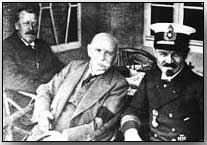 On
the 5th of August Strasser himself led the last big raid against Britain,
leading a fleet of five Height-Climbers. Strasser was flying in L70 -
his most advanced airship, capable, he hoped, of flying bombing missions
against New York. But by this time the British had aircraft that could
operate at about 20,000 feet as well, and L70 succumbed to a two man DH4
piloted by Egbert Cadbury. (He was a member of the famous chocolate
manufacturing family.)
On
the 5th of August Strasser himself led the last big raid against Britain,
leading a fleet of five Height-Climbers. Strasser was flying in L70 -
his most advanced airship, capable, he hoped, of flying bombing missions
against New York. But by this time the British had aircraft that could
operate at about 20,000 feet as well, and L70 succumbed to a two man DH4
piloted by Egbert Cadbury. (He was a member of the famous chocolate
manufacturing family.)
The fatal shots were fired by his gunner, Robert Leckie, whose hands were almost frozen because he had not had time to put on gloves when he and Cadbury had scrambled to chase the Zeppelins. The rest of the airships dropped their bombs on what they thought were "targets of opportunity", but in fact they dropped them in the sea.
The Zeppelin attacks had a profound psychological impact on the Allies. The Germans were ordered, under the treaty of Versailles, to hand over all their airships, but their crews preferred to destroy as many of them as they could.
The need to tie up numerous squadron in home defence can be marked as the Zeppelin's greatest achievement, for as a weapon of war they proved themselves unsatisfactory. Of the 115 Zeppelins employed by the Germans, 53 were destroyed and a further 24 were too damaged to be operational. Strasser's crews suffered a 40% loss rate. The cost of constructing those 115 Zeppelins was approximately five times the cost of the damage they inflicted.
Article contributed by Ari Unikoski
Photographs courtesy of Photos of the Great War website
Next - Bombers - Germany: Gotha and Giant, the Bomber Aircraft
"Hun" was a slang term used by the allies, to describe the Germans. "Boche" was another.
- Did you know?
